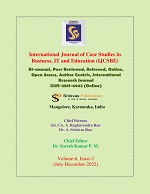Collaborative Social Engagement (CSE) Model – A Best Practice of Srinivas University, India
Main Article Content
Abstract
Purpose: To introduce the Collaborative Social Engagement (CSE) model as one of the best practices useful to higher education institutions for creating their social footprints of Service. The paper showcases the practice framework of the model by showcasing its impact on skill development, social service, social welfare and sustainability. The study carry out an outcome analysis of the best practice with the help of ABCD analysis framework.
Methodology: It is a Case study prepared on the reports published in the Srinivas University website. The requisite data is collected from the respective Coordinators appointed by the University to carry out the projects of Unnat Bharat Abhiyan Forum, Bosch Industry Academia Collaboration Centre, Srinivas Institute of Rural Reconstruction Agency, School Adoption Programme and Centre for Popularisation of Science and Technology. The content is analysed by review of literature and ABCD analysis framework.
Results & Outcome: The study recommends an innovative best practice model for the higher education institutions to carry out ‘Social Engagement’ as a service model to reach out to Society.
Originality: The paper introduces the ‘Collaborative Social Engagement’ model suitable for Institutions of Higher Education to carry out social responsibility by blending the outcomes of NGO interventions, Industry-Academia Collaboration, Village and School Adoption, public sensitization, and social service initiatives, etc.
Type of Paper: Case study on Best Practice.
